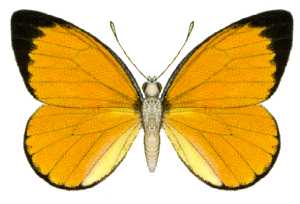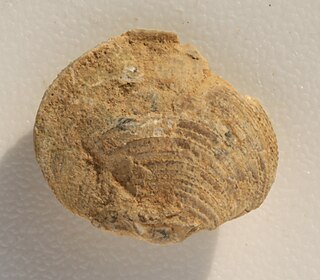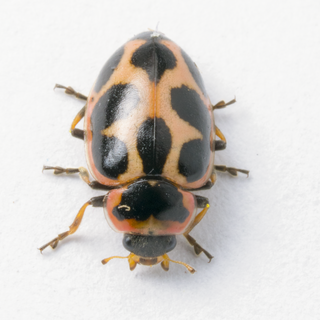
The small dusty wave is a moth of the family Geometridae first described by Franz von Paula Schrank in 1802. It is found throughout Western, Central and Northern Europe. In the north, its range extends as far as Denmark and southern Scandinavia. In the east its range extends as far as Russia. Idaea seriata is replaced by the subspecies Idaea seriata canteneraria, from the north-east of Spain and the central and eastern Mediterranean to the Crimean peninsula, while the western Mediterranean and the Balearic Islands are inhabited by the sister species Idaea minuscularia. Outside Europe it is found in eastern Algeria, Tunisia, Turkey, Cyprus, the Caucasus and the northwest of Transcaucasia. In Morocco and western Algeria, it is replaced by the sister species Idaea minuscularia. In the British Isles it is common in England and Wales but is only found in the eastern half of Scotland and it is rare in Ireland.
Ceraurinella is an extinct genus of trilobite in the family Cheiruridae. There are about 19 described species in Ceraurinella.

Delias aruna, the golden Jezebel, is a butterfly in the family Pieridae. It is found in Queensland, Irian Jaya, Maluku, Papua New Guinea and several surrounding islands.
Aspilapteryx seriata is a moth of the family Gracillariidae. It is known from South Africa.
Noctileptura seriata is the species of the Lepturinae subfamily in long-horned beetle family. This beetle is distributed in Guatemala, and Honduras.

Continenticola is a clade that includes the land planarians (Geoplanidae) and the freshwater triclads.

Geoplanoidea is a superfamily of freshwater and land triclads that comprises the species of the Geoplanidae and the Dugesiidae families.
Caraphia is a genus of longhorned beetles in the family Cerambycidae, found in Central America.
Grapevine trunk diseases (GTD) are the most destructive diseases of vineyards worldwide. Fungicides with the potential to control GTD have been banned in Europe and there are no highly effective treatments available. Action to develop new strategies to fight these diseases are needed.
Diplodia seriata is an anamorphic fungus species in the genus Diplodia. It is a cause of bot canker of grapevine in Mexico.
Teldenia seriata is a moth in the family Drepanidae. Warren described it in 1922. It is found in New Guinea and on Goodenough Island.

Sybra seriata is a species of beetle in the family Cerambycidae. It was described by Pascoe in 1867.

Melaleuca seriata is a shrub in the myrtle family, Myrtaceae, and is endemic to the south-west of Western Australia. In describing it, John Lindley wrote "Melaleuca seriata, parviceps, and trichophylla, are bushes, every twig of which is terminated by hemispherical heads of a brilliant pink." It is very similar to Melaleuca parviceps.

Cleiothyridina is an extinct genus of brachiopods.
Rhodopina seriata is a species of beetle in the family Cerambycidae. It was described by Per Olof Christopher Aurivillius in 1913. It is known from Borneo, Java, and Sumatra.
Dasylophia seriata, the western legume prominent, is a species of moth in the family Notodontidae. It was first described by Druce in 1887 and it is found in North America.
Syneta seriata is a species of leaf beetle. It is found in North America. It feeds on California live oak and California black oak.

Naemia seriata, commonly known as the seaside lady beetle, is a large coccinellid beetle native to North America, and the only species in the genus Naemia. It is found in coastal areas such as beaches, salt marshes, and bay islands on the Atlantic and Pacific coast. This beetle is light brown, yellow, orange, or red in color, with large black spots, often connected along the sides. The pronotum usually has one large central black spot, which is occasionally split into two spots. The body of this species is elongately oval in shape, and between 4 and 6.7mm in length. The two subspecies can be distinguished by markings on the head, with the head of N. seriata seriata being black, while the head of N. seriata litigiosa has a pale triangular marking. Naemia seriata seriata is primarily distributed across Eastern North America, while N. seriata litigiosa is restricted to the American Southwest.
Caraphia lingafelteri is a species of beetle in the family Cerambycidae. It was described by Ohbayashi and Yamasako in 2016. It is found in Matagalpa Department in Nicaragua.
Caraphia squamosa is a species of beetle in the family Cerambycidae. It was described by Chemsak and Linsley in 1984. It is found in the Southern regions of Mexico.







